Preparation of Amine-Modified Cu-Mg-Al LDH Composite Photocatalyst
Abstract
:1. Introduction
2. Materials and Methods
2.1. Materials
2.2. Preparation of Amine-Modified Cu-Mg-Al LDHs
2.3. Characterization
2.4. CO2 Adsorption Capacity and Sequential Adsorption-Regeneration Cycles
2.5. Photocatalytic CO2 Reduction Test
3. Results and Discussion
3.1. Characterization Results of Cu-Mg-Al LDHs
3.1.1. Elemental Analysis
3.1.2. XRD Analysis
3.1.3. Microstructure Observation
3.1.4. FTIR Analysis
3.1.5. Thermal Analysis
3.1.6. XPS Analysis
3.2. CO2 Adsorption Performance
3.2.1. Effect of the Amine Loading
3.2.2. Effect of the Temperature
3.2.3. Effect of Sequential Adsorption-Regeneration Cycles
3.2.4. Adsorption Kinetics
3.3. Photocatalytic CO2 Reduction
4. Conclusions
Author Contributions
Funding
Institutional Review Board Statement
Informed Consent Statement
Data Availability Statement
Conflicts of Interest
References
- Brune, S.; Williams, S.E.; Muller, R.D. Potential links between continental rifting, CO2 degassing and climate change through time. Nat. Geosci. 2017, 10, 941–946. [Google Scholar] [CrossRef]
- Keith, D.W. Why capture CO2 from the atmosphere? Science 2009, 325, 1654–1655. [Google Scholar] [CrossRef] [PubMed]
- Koelbl, B.S.; van den Broek, M.A.; Faaij, A.P.C.; van Vuuren, D.P. Uncertainty in carbon capture and storage (CCS) deployment projections: A cross-model comparison exercise. Clim. Chang. 2014, 123, 461–476. [Google Scholar] [CrossRef]
- Bui, M.; Adjiman, C.S.; Bardow, A.; Anthony, E.J.; Boston, A.; Brown, S.; Fennell, P.S.; Fuss, S.; Galindo, A.; Hackett, L.A.; et al. Carbon capture and storage (CCS): The way forward. Energy Environ. Sci. 2018, 11, 1062–1176. [Google Scholar] [CrossRef] [Green Version]
- Perejon, A.; Romeo, L.M.; Lara, Y.; Lisbona, P.; Martinez, A.; Valverde, J.M. The calcium-looping technology for CO2 capture: On the important roles of energy integration and sorbent behavior. Appl. Energy 2016, 162, 787–807. [Google Scholar] [CrossRef] [Green Version]
- Seftel, E.M.; Mertens, M.; Cool, P. The influence of the Ti4+ location on the formation of self-assembled nanocomposite systems based on TiO2 and Mg/Al-LDHs with photocatalytic properties. Appl. Catal. B-Environ. 2013, 12, 274–285. [Google Scholar] [CrossRef]
- Carja, G.; Grosu, E.F.; Mureseanu, M.; Lutic, D. A family of solar light responsive photocatalysts obtained using Zn2+ Me3+ (Me = Al/Ga) LDHs doped with Ga2O3 and In2O3 and their derived mixed oxides: A case study of phenol/4-nitrophenol decomposition. Catal. Sci. Technol. 2017, 7, 5402–5412. [Google Scholar] [CrossRef]
- Li, X.; Yu, J.G.; Jaroniec, M. Hierarchical photocatalysts. Chem. Soc. Rev. 2016, 45, 2603–2636. [Google Scholar] [CrossRef]
- Li, C.M.; Wei, M.; Evans, D.G.; Duan, X. Layered double hydroxide-based nanomaterials as highly efficient catalysts and adsorbents. Small 2014, 10, 4469–4486. [Google Scholar] [CrossRef]
- Wu, Y.; Wang, H.; Sun, Y.M.; Xiao, T.; Tu, W.G.; Yuan, X.Z.; Zeng, G.M.; Li, S.Z.; Chew, J.W. Photogenerated charge transfer via interfacial internal electric field for significantly improved photocatalysis in direct Z-scheme oxygen-doped carbon nitrogen/CoAl-layered double hydroxide heterojunction. Appl. Catal. B-Environ. 2018, 227, 530–540. [Google Scholar] [CrossRef]
- Ziarati, A.; Badiei, A.; Grillo, R.; Burgi, T. 3D yolk@shell TiO2-x/LDH architecture: Tailored structure for visible light CO2 conversion. ACS Appl. Mater. Inter. 2019, 11, 5903–5910. [Google Scholar] [CrossRef]
- Garcia-Gallastegui, A.; Iruretagoyena, D.; Mokhtar, M.; Asiri, A.M.; Basahel, S.N.; Al-Thabaiti, S.A.; Alyoubi, A.O.; Chadwick, D.; Shaffer, M.S.P. Layered double hydroxides supported on multi-walled carbon nanotubes: Preparation and CO2 adsorption characteristics. J. Mater. Chem. 2012, 22, 13932–13940. [Google Scholar] [CrossRef]
- Reddy, M.K.R.; Xu, Z.P.; Lu, G.Q.; da Costa, J.C.D. Layered double hydroxides for CO2 capture: Structure evolution and regeneration. Ind. Eng. Chem. Res. 2006, 45, 7504–7509. [Google Scholar] [CrossRef]
- Iruretagoyena, D.; Shaffer, M.S.P.; Chadwick, D. Adsorption of carbon dioxide on graphene oxide supported layered double oxides. Adsorption 2014, 20, 321–330. [Google Scholar] [CrossRef]
- Tahawy, R.; Doustkhah, E.; Abdel-Aal, E.S.A.; Esmat, M.; Farghaly, F.E.; El-Hosainy, H.; Tsunoji, N.; El-Hosiny, F.I.; Yamauchi, Y.; Assadi, M.H.N.; et al. Exceptionally stable green rust, a mixed-valent iron-layered double hydroxide, as an efficient solar photocatalyst for H2 production from ammonia borane. Appl. Catal. B-Environ. 2021, 286, 119854. [Google Scholar] [CrossRef]
- Xia, S.J.; Zhang, L.Y.; Zhou, X.B.; Pan, G.X.; Ni, Z.M. The photocatalytic property for water splitting and the structural stability of CuMgM layered double hydroxides (M = Al, Cr, Fe, Ce). Appl. Clay Sci. 2015, 114, 577–585. [Google Scholar] [CrossRef]
- Gong, C.; Chen, F.; Yang, Q.; Luo, K.; Yao, F.B.; Wang, S.N.; Wang, X.L.; Wu, J.W.; Li, X.M.; Wang, D.B.; et al. Heterogeneous activation of peroxymonosulfate by Fe-Co layered doubled hydroxide for efficient catalytic degradation of Rhoadmine B. Chem. Eng. J. 2017, 321, 222–232. [Google Scholar] [CrossRef]
- Zhang, C.; Li, Y.Q.; Wang, F.H.; Yu, Z.G.; Wei, J.J.; Yang, Z.Z.; Ma, C.; Li, Z.H.; Xu, Z.Y.; Zeng, G.M. Performance of magnetic zirconium-iron oxide nanoparticle in the removal of phosphate from aqueous solution. Appl. Surf. Sci. 2017, 396, 1783–1792. [Google Scholar] [CrossRef]
- Hou, X.J.; Li, H.Q.; He, P.; Sun, Z.H.; Li, S.P. Structural and electronic analysis of Li/Al layered double hydroxides and their adsorption for CO2. Appl. Surf. Sci. 2017, 416, 411–423. [Google Scholar] [CrossRef]
- Zhu, X.C.; Shi, Y.X.; Cai, N.S. High-pressure carbon dioxide adsorption kinetics of potassium-modified hydrotalcite at elevated temperature. Fuel 2017, 207, 579–590. [Google Scholar] [CrossRef]
- Qin, Q.Q.; Wang, J.Y.; Zhou, T.T.; Zheng, Q.W.; Huang, L.; Zhang, Y.; Lu, P.; Umar, A.; Louis, B.; Wang, Q. Impact of organic interlayer anions on the CO2 adsorption performance of Mg-Al layered double hydroxides derived mixed oxides. J. Energy Chem. 2017, 26, 346–353. [Google Scholar] [CrossRef] [Green Version]
- Zhong, H.; Tian, Y.L.; Yang, Q.; Brusseau, M.L.; Yang, L.; Zeng, G.M. Degradation of landfill leachate compounds by persulfate for groundwater remediation. Chem. Eng. J. 2017, 307, 399–407. [Google Scholar] [CrossRef] [Green Version]
- Yilmaz, M.S. Synthesis of novel amine modified hollow mesoporous silica@Mg-Al layered double hydroxide composite and its application in CO2 adsorption. Micropor. Mesopor. Mat. 2017, 245, 109–117. [Google Scholar] [CrossRef]
- Silva, J.M.; Trujillano, R.; Rives, V.; Soria, M.A.; Madeira, L.M. High temperature CO2 sorption over modified hydrotalcites. Chem. Eng. J. 2017, 325, 25–34. [Google Scholar] [CrossRef]
- De Marco, M.; Menzel, R.; Bawaked, S.M.; Mokhtar, M.; Obaid, A.Y.; Basahel, S.N.; Shaffer, M.S.P. Hybrid effects in graphene oxide/carbon nanotube-supported layered double hydroxides: Enhancing the CO2 sorption properties. Carbon 2017, 123, 616–627. [Google Scholar] [CrossRef]
- Zhao, Y.; Tian, N.; Wang, J.W.; Wang, Q.N.; Jiang, Q.D.; Ai, N. Synthesis of amine modified Mg-Al LDHs and their CO2 adsorption characteristics. J. Chem. Eng. Chin. Univ. 2018, 32, 659–666. [Google Scholar]
- Ai, N.; Jiang, Z.; Xu, Q.; Qian, Q.F.; Wu, X.; Wang, J.W. Preparation of amine modified layered double hydroxide and its adsorption mechanism for CO2. Chin. J. Chem. Ind. Eng. 2013, 64, 616–623. [Google Scholar]
- Wang, J.W.; Stevens, L.A.; Drage, T.C.; Wood, J. Preparation and CO2 adsorption of amine modified Mg-Al LDH via exfoliation route. Chem. Eng. Sci. 2012, 68, 424–431. [Google Scholar] [CrossRef]
- Wang, J.W.; Stevens, L.A.; Drage, T.C.; Snape, C.E.; Wood, J. Preparation and CO2 adsorption of amine modified layered double hydroxide via anionic surfactant-mediated route. Chem. Eng. J. 2012, 181, 267–275. [Google Scholar] [CrossRef]
- Fu, S.F.; Zheng, Y.; Zhou, X.B.; Ni, Z.M.; Xia, S.J. Visible light promoted degradation of gaseous volatile organic compounds catalyzed by Au supported layered double hydroxides: Influencing factors, kinetics and mechanism. J. Hazard. Mater. 2019, 363, 41–54. [Google Scholar] [CrossRef]
- Tang, P.G.; Feng, Y.J.; Li, D.Q. Synthesis and applications of layered double hydroxides based pigments. Recent Pat. Nanotech. 2012, 6, 193–199. [Google Scholar] [CrossRef] [PubMed]
- Zhang, H.W.; Itoi, T.; Konishi, T.; Izumi, Y. Dual photocatalytic roles of light: Charge separation at the band gap and heat via localized surface plasmon resonance to convert CO2 into CO over silver-zirconium oxide. J. Am. Chem. Soc. 2019, 141, 6292–6301. [Google Scholar] [CrossRef] [PubMed]
- Yang, Z.Z.; Wei, J.J.; Zeng, G.M.; Zhang, H.Q.; Tan, X.F.; Ma, C.; Li, X.C.; Li, Z.H.; Zhang, C. A review on strategies to LDH-based materials to improve adsorption capacity and photoreduction efficiency for CO2. Coordin. Chem. Rev. 2019, 386, 154–182. [Google Scholar] [CrossRef]
- Iguchi, S.; Hasegawa, Y.; Teramura, K.; Hosokawa, S.; Tanaka, T. Preparation of transition metal-containing layered double hydroxides and application to the photocatalytic conversion of CO2 in water. J. CO2 Util. 2016, 15, 6–14. [Google Scholar] [CrossRef] [Green Version]
- Casillas, J.E.; Tzompantzi, F.; Castellanos, S.G.; Mendoza-Damian, G.; Perez-Hernandez, R.; Lopez-Gaona, A.; Barrera, A. Promotion effect of ZnO on the photocatalytic activity of coupled Al2O3-Nd2O3-ZnO composites prepared by the sol-gel method in the degradation of phenol. Appl. Catal. B-Environ. 2017, 208, 161–170. [Google Scholar] [CrossRef]
- Doustkhah, E.; Hassandoost, R.; Khataee, A.; Luque, R.; Assadi, M.H.N. Hard-templated metal–organic frameworks for advanced applications. Chem. Soc. Rev. 2021, 50, 2927–2953. [Google Scholar] [CrossRef]
- Menezes, W.G.; Altmann, L.; Zielasek, V.; Thiel, K.; Bäumer, M. Bimetallic Co-Pd catalysts: Study of preparation methods and their influence on the selective hydrogenation of acetylene. J. Catal. 2013, 300, 125–135. [Google Scholar] [CrossRef]
- Zhang, G.H.; Zhang, X.Q.; Meng, Y.; Pan, G.X.; Ni, Z.M.; Xia, S.J. Layered double hydroxides-based photocatalysts and visible-light driven photodegradation of organic pollutants: A review. Chem. Eng. J. 2020, 392, 123684. [Google Scholar] [CrossRef]
- Chen, C.R.; Zeng, H.Y.; Yi, M.Y.; Xiao, G.F.; Zhu, R.L.; Cao, X.J.; Shen, S.G.; Peng, J.W. Fabrication of Ag2O/Ag decorated ZnAl-layered double hydroxide with enhanced visible light photocatalytic activity for tetracycline degradation. Ecotox. Environ. Safe. 2019, 172, 423–431. [Google Scholar] [CrossRef]
- Hong, J.D.; Zhang, W.; Wang, Y.B.; Zhou, T.H.; Xu, R. Photocatalytic reduction of carbon dioxide over self-assembled carbon nitride and layered double hydroxide: The role of carbon dioxide enrichment. ChemCatChem 2014, 6, 2315–2321. [Google Scholar] [CrossRef]
- Ju, L.T.; Wu, P.X.; Lai, X.L.; Yang, S.S.; Gong, B.N.; Chen, M.Q.; Zhu, N.W. Synthesis and characterization of fullerene modified ZnAlTi-LDO in photo-degradation of bisphenol A under simulated visible light irradiation. Environ. Pollut. 2017, 228, 234–244. [Google Scholar] [CrossRef]
- Puscasu, C.M.; Seftel, E.M.; Mertens, M.; Cool, P.; Carja, G. ZnTiLDH and the derived mixed oxides as mesoporous nanoarchitectonics with photocatalytic capabilities. J. Inorg. Organomet. P. 2015, 25, 259–266. [Google Scholar] [CrossRef]
- Ahmed, N.; Shibata, Y.; Taniguchi, T.; Izumi, Y. Photocatalytic conversion of carbon dioxide into methanol using zinc-copper-M(III) (M = aluminum, gallium) layered double hydroxides. J. Catal. 2011, 279, 123–135. [Google Scholar] [CrossRef]
- Ahmed, N.; Morikawa, M.; Izumi, Y. Photocatalytic conversion of carbon dioxide into methanol using optimized layered double hydroxide catalysts. Catal. Today 2012, 185, 263–269. [Google Scholar] [CrossRef]
- Morikawa, M.; Ogura, Y.; Ahmed, N.; Kawamura, S.; Mikami, G.; Okamoto, S.; Izumi, Y. Photocatalytic conversion of carbon dioxide into methanol in reverse fuel cells with tungsten oxide and layered double hydroxide photocatalysts for solar fuel generation. Catal. Sci. Technol. 2014, 4, 1644–1651. [Google Scholar] [CrossRef]
- Intissar, M.; Seron, A.; Giovannelli, F.; Autret, C.; Motelica-Heino, M.; Delorme, F. Effect of copper content on the synthesis and properties of (Mg4−xCux)Al2OH12CO3, nH2O layered double hydroxides. J. Mater. Sci. 2015, 50, 1427–1434. [Google Scholar] [CrossRef] [Green Version]
- Wang, L.G.; Shi, W.; Yao, P.; Ni, Z.M.; Li, Y.; Liu, J. Microstructure and Jahn-Teller effect of Cu-Zn-Mg-Al layered double hydroxides. Acta Phys.-Chim. Sin. 2012, 28, 58–64. [Google Scholar]
- Mack, K.; von Leupoldt, A.W.; Forster, C.; Ezhevskaya, M.; Hinderberger, D.; Klinkhammer, K.W.; Heinze, K. Effect of chelate ring expansion on Jahn-Teller distortion and Jahn Teller dynamics in copper(II) complexes. Inorg. Chem. 2012, 51, 7851–7858. [Google Scholar] [CrossRef]
- Liu, J.; Yao, P.; Ni, Z.M.; Li, Y.; Shi, W. Jahn-Teller effect of Cu-Mg-Al layered double hydroxides. Acta Phys.-Chim. Sin. 2011, 27, 2088–2094. [Google Scholar]
- Park, A.Y.; Kwon, H.; Woo, A.J.; Kim, S.J. Layered double hydroxide surface modified with (3-aminopropyl)triethoxysilane by covalent bonding. Adv. Mater. 2005, 17, 106–109. [Google Scholar] [CrossRef]
- Zhu, X.C.; Ge, T.S.; Yang, F.; Lyu, M.; Chen, C.P.; O’Hare, D.; Wang, R.Z. Efficient CO2 capture from ambient air with amine-functionalized Mg-Al mixed metal oxides. J. Mater. Chem. A 2020, 8, 16421–16428. [Google Scholar] [CrossRef]
- Tao, Q.; He, H.P.; Frost, R.L.; Yuan, P.; Zhu, J.X. Nanomaterials based upon silylated layered double hydroxides. Appl. Surf. Sci. 2009, 255, 4334–4340. [Google Scholar] [CrossRef]
- Kong, Y.; Jiang, G.D.; Wu, Y.; Cui, S.; Shen, X.D. Amine hybrid aerogel for high-efficiency CO2 capture: Effect of amine loading and CO2 concentration. Chem. Eng. J. 2016, 306, 362–368. [Google Scholar] [CrossRef]
- Chen, Y.; Hong, H.F.; Cai, J.Y.; Li, Z.H. Highly efficient CO2 to CO transformation over Cu-based catalyst derived from a CuMgAl-layered double hydroxide (LDH). ChemCatChem 2021, 13, 656–663. [Google Scholar] [CrossRef]
- Narasimharao, K.; Al-Sabban, E.; Saleh, T.S.; Gallastegui, A.G.; Sanfiz, A.C.; Basahel, S.; Al-Thabaiti, S.; Alyoubi, A.; Obaid, A.; Mokhtar, M. Microwave assisted efficient protocol for the classic Ullmann homocoupling reaction using Cu-Mg-Al hydrotalcite catalysts. J. Mol. Catal. A-Chem. 2013, 379, 152–162. [Google Scholar] [CrossRef]
- Liu, Q.P.; Zhao, Y.; Wang, J.W.; Ai, N. Ultrasound assisted synthesis of amine modified Mg-Al LDHs and its application in CO2 adsorption. J. Chem. Eng. Chin. Univ. 2020, 34, 479–486. [Google Scholar]
- Ezeh, C.I.; Huang, X.N.; Yang, X.G.; Sun, C.G.; Wang, J.W. Sonochemical surface functionalization of exfoliated LDH: Effect on textural properties, CO2 adsorption, cyclic regeneration capacities and subsequent gas uptake for simultaneous methanol synthesis. Ultrason. Sonochem. 2017, 39, 330–343. [Google Scholar] [CrossRef] [Green Version]
- Li, R.H.; Wang, J.J.; Zhou, B.Y.; Awasthi, M.K.; Ali, A.; Zhang, Z.Q.; Gaston, L.A.; Lahori, A.H.; Mahar, A. Enhancing phosphate adsorption by Mg/Al layered double hydroxide functionalized biochar with different Mg/Al ratios. Sci. Total Environ. 2016, 559, 121–129. [Google Scholar] [CrossRef] [Green Version]
- Loganathan, S.; Tikmani, M.; Mishra, A.; Ghoshal, A.K. Amine tethered pore-expanded MCM-41 for CO2 capture: Experimental, isotherm and kinetic modeling studies. Chem. Eng. J. 2016, 303, 89–99. [Google Scholar] [CrossRef]
- Qu, J.; Sha, L.; Wu, C.J.; Zhang, Q.W. Applications of mechanochemically prepared layered double hydroxides as adsorbents and catalysts: A mini-review. Nanomaterials 2019, 9, 80. [Google Scholar] [CrossRef] [Green Version]
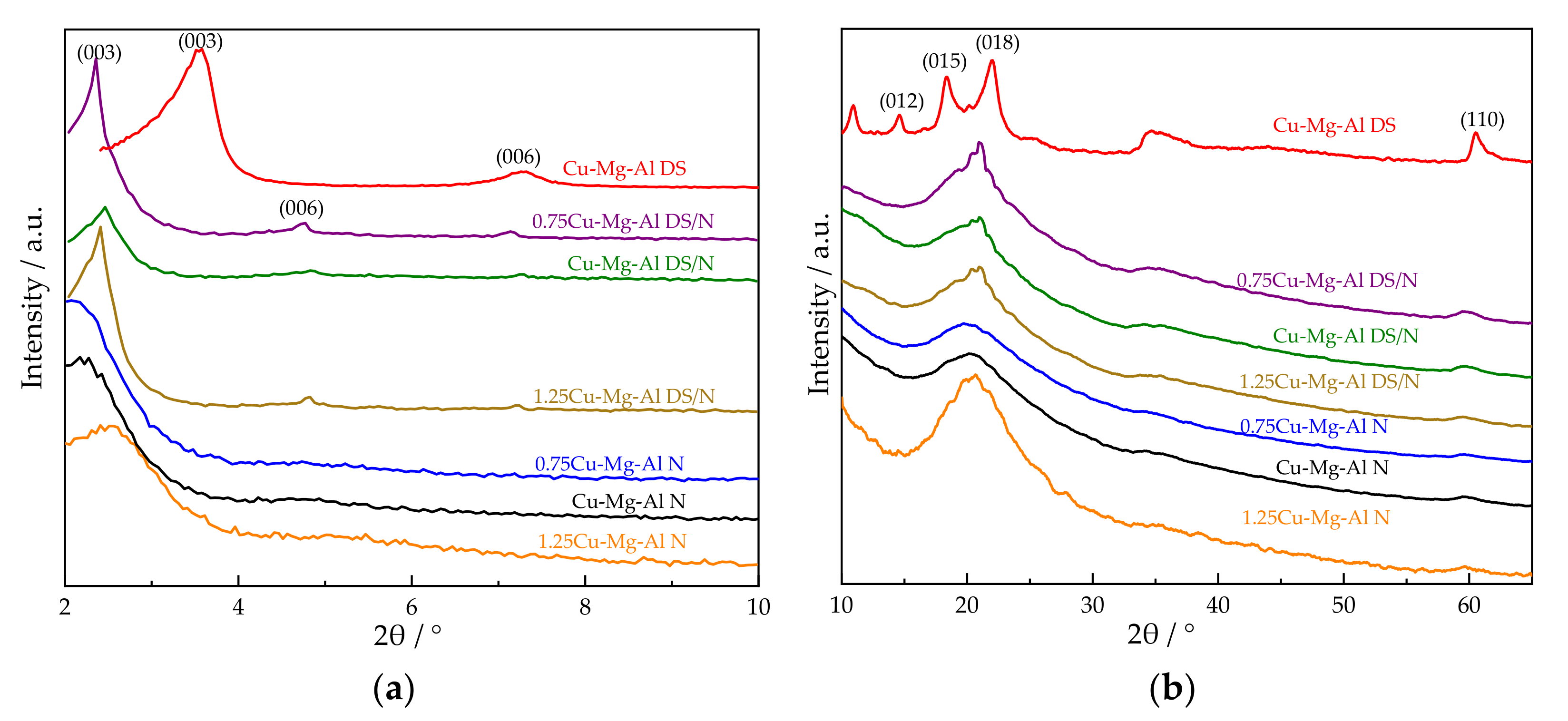
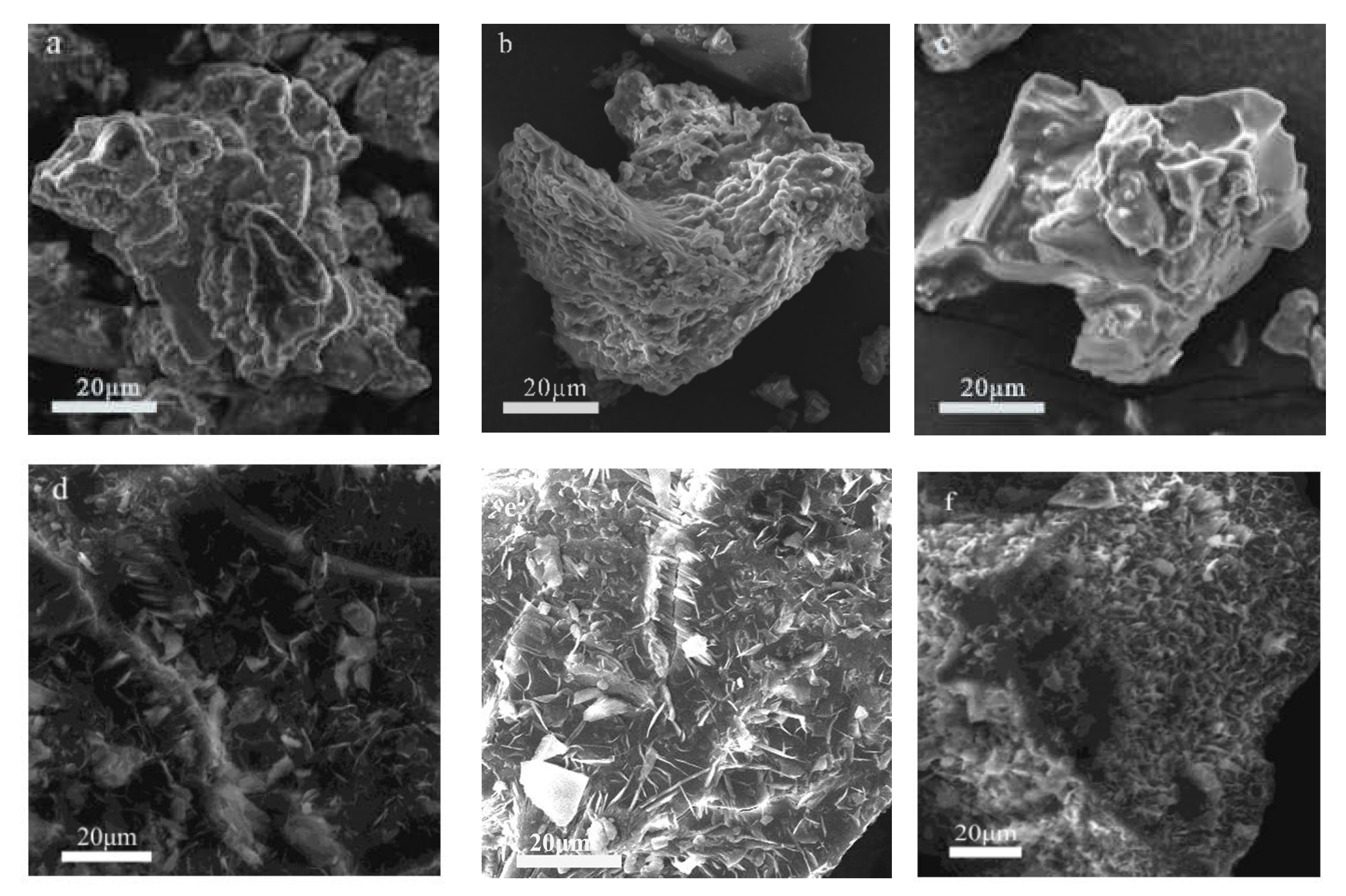
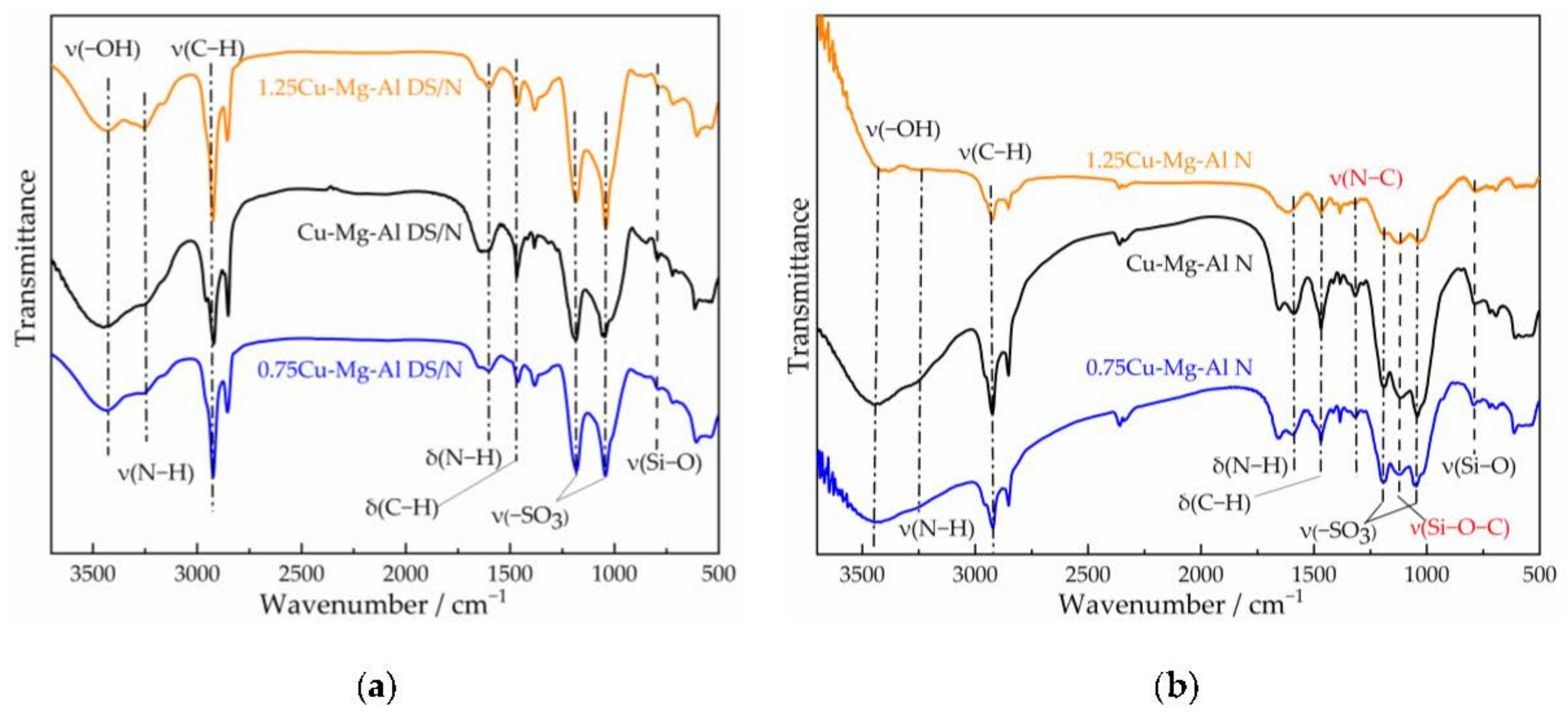



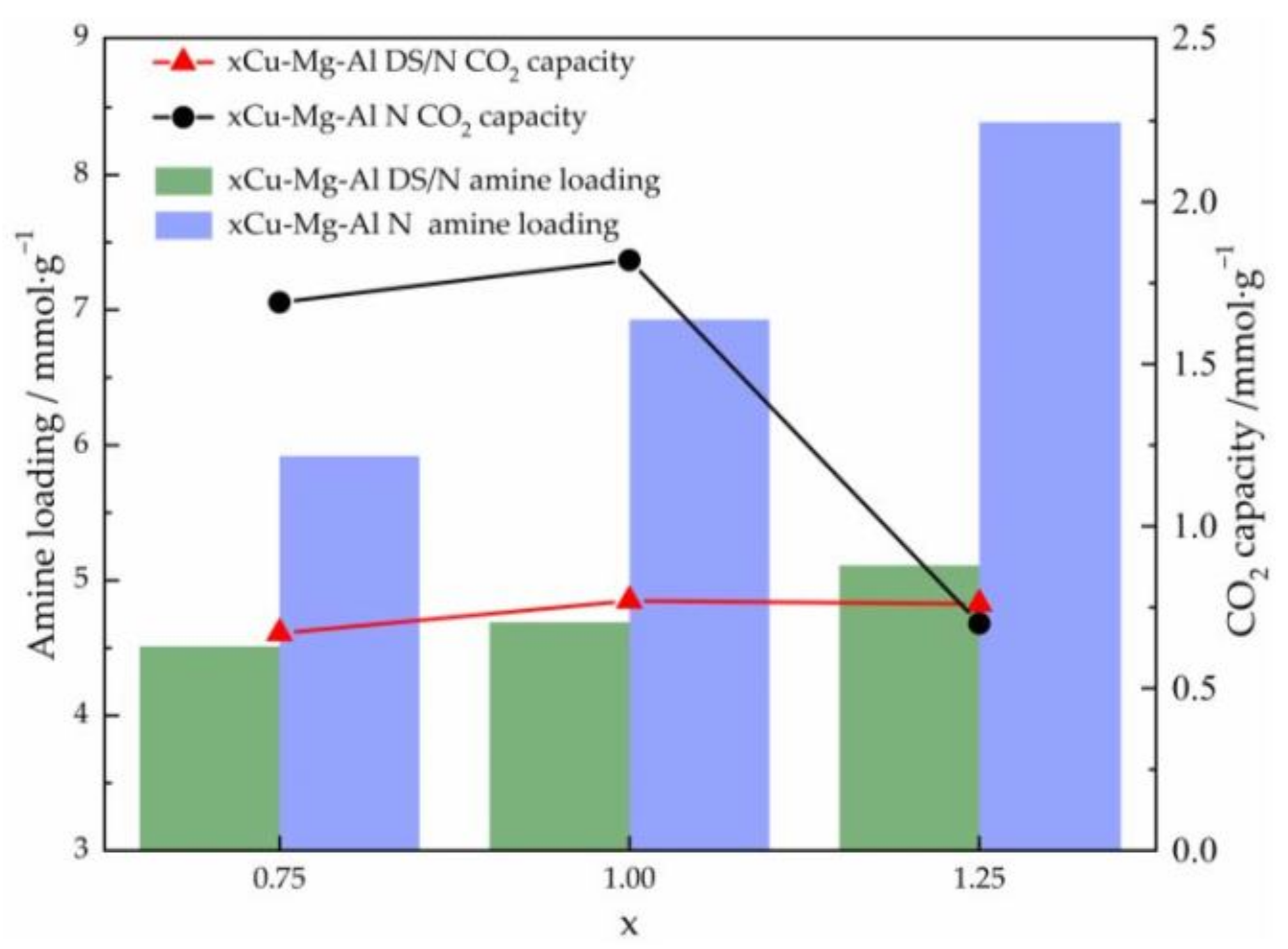
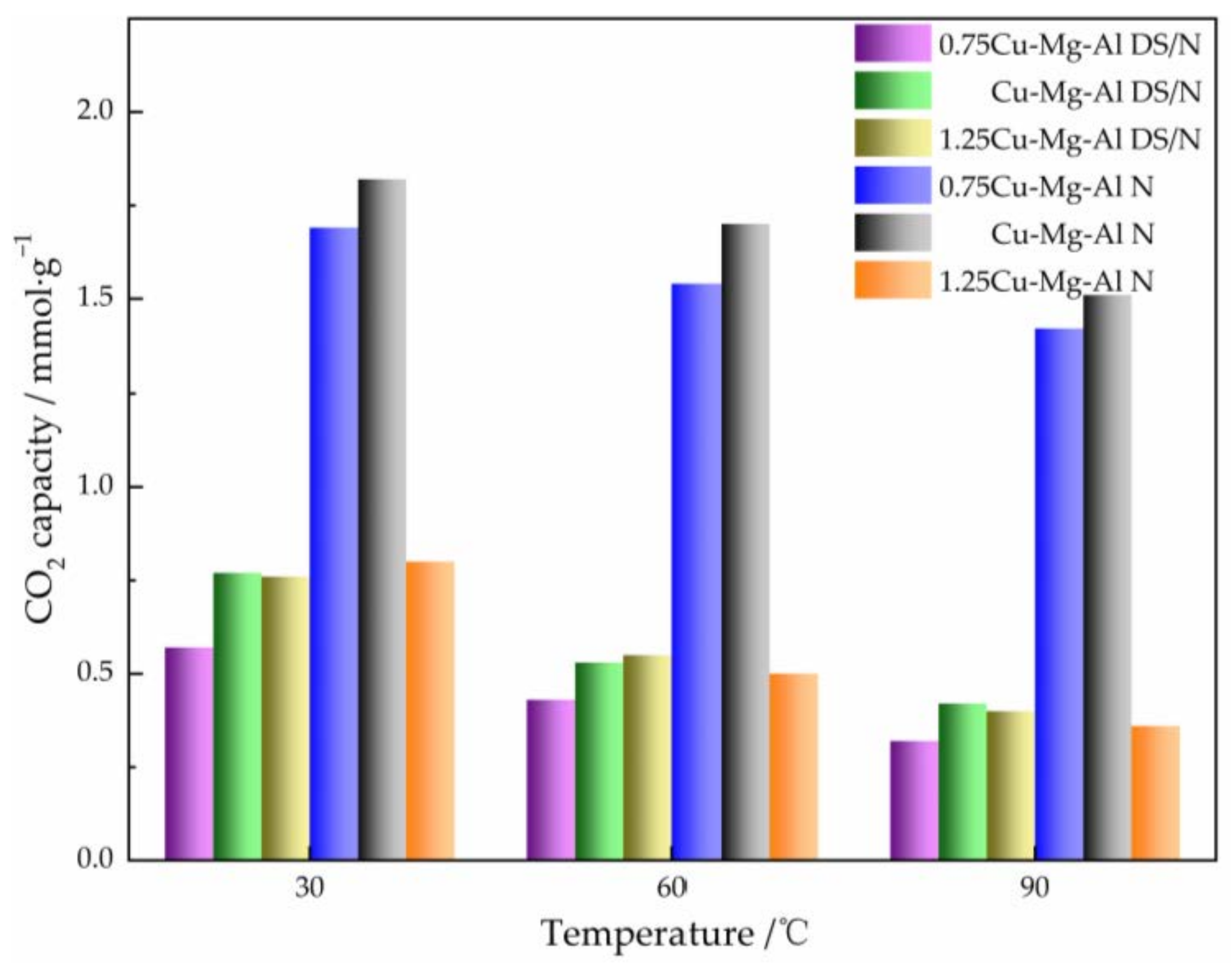
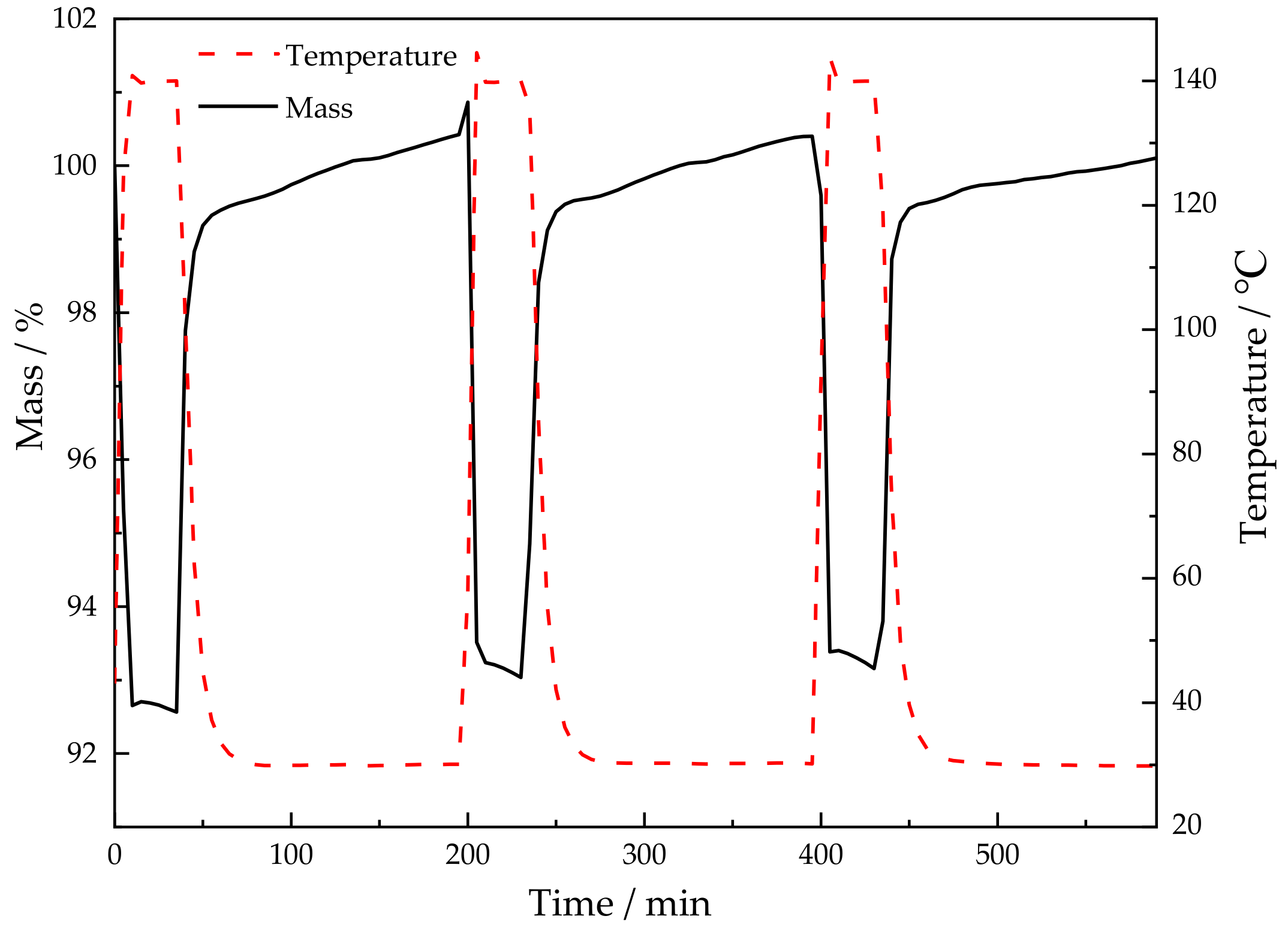


| Sample | Elemental Weight (%) | Formula for Intercalated Molecules | Amine Loading | |||
|---|---|---|---|---|---|---|
| N | C | H | S | (mmol·g−1) | (mmol·g−1) | |
| 0.75Cu-Mg-Al DS/N | 6.31 | 36.58 | 7.65 | 3.95 | (C12H25SO3−)1.24(C6.95H20.23SiN2O3)2.25 | 4.51 |
| Cu-Mg-Al DS/N | 6.57 | 36.62 | 7.71 | 4.47 | (C12H25SO3−)1.40(C5.87H17.96SiN2O3)2.35 | 4.69 |
| 1.25Cu-Mg-Al DS/N | 7.15 | 36.27 | 7.53 | 4.28 | (C12H25SO3−)1.34(C5.55H16.39SiN2O3)2.55 | 5.11 |
| 0.75Cu-Mg-Al N | 8.29 | 34.34 | 7.42 | 2.04 | (C12H25SO3−)0.64(C7.08H19.68SiN2O3)2.96 | 5.92 |
| Cu-Mg-Al N | 9.70 | 36.30 | 7.49 | 1.49 | (C12H25SO3−)0.47(C7.12H18.26SiN2O3)3.46 | 6.93 |
| 1.25Cu-Mg-Al N | 11.75 | 35.98 | 7.83 | 1.46 | (C12H25SO3−)0.46(C5.84H15.94SiN2O3)4.20 | 8.39 |
| Sample | First Stage (%) | Second Stage (%) | Third Stage (%) |
|---|---|---|---|
| 0.75Cu-Mg-Al DS/N | 7.7 | 8.5 | 43.2 |
| Cu-Mg-Al DS/N | 6.1 | 9.7 | 47.8 |
| 1.25Cu-Mg-Al DS/N | 4.8 | 10.1 | 39.9 |
| 0.75Cu-Mg-Al N | 13.5 | 6.5 | 39.7 |
| Cu-Mg-Al N | 10.5 | 6.3 | 37.0 |
| 1.25Cu-Mg-Al N | 8.9 | 6.1 | 42.4 |
| Sample | Grafting Agent | Temperature (°C) | CO2 Adsorption (Capacity mmol−1·g−1) | Reference |
|---|---|---|---|---|
| Mg-Al N2 | N-aminoethyl-γ-aminopropyltrimethoxysilane | 30 | 2.26 | [26] |
| NiMgAl N2 | N-[3-(Trimethoxysilyl)propyl]ethylenediamine | 80 | 2.02 | [27] |
| Cu-Mg-Al N | N-aminoethyl-γ-aminopropyltrimethoxysilane | 30 | 1.82 | This work |
| MgAl N3 | 3-[2-(2-Aminoethylamino) ethylamino]propyl-trimethoxysilane | 80 | 1.76 | [28] |
| UL30-LDH | N-aminoethyl-gamma-aminopropyltrimethoxysilane | 30 | 1.65 | [56] |
| MgAl MEA 1 | 3-aminopropyl triethoxysilane | 25 | 1.39 | [29] |
| UH-MEA5 | (3-aminopropyl)-triethoxysilane | 55 | 1.37 | [57] |
| N1-HMS@Mg-Al LDH | N1-(3-Trimethoxysilylpropyl) diethylenetriamine | 75 | 1.28 | [23] |
| Samples | Pseudo-1st-Order | Err | R2 | Pseudo-2nd-Order | Err | R2 | Double-Exponential | Err | R2 | ||||||
|---|---|---|---|---|---|---|---|---|---|---|---|---|---|---|---|
| qe | kf | (%) | qe | kf | (%) | qe | A1 | A2 | k1 | k2 | (%) | ||||
| 0.75Cu-Mg-Al DS/N | 0.61 | 0.06 | 0.45 | 0.8139 | 0.67 | 0.13 | 0.43 | 0.9372 | 0.70 | 0.35 | 0.36 | 0.01 | 0.31 | 0.18 | 0.9989 |
| Cu-Mg-Al DS/N | 0.72 | 0.02 | 0.56 | 0.9357 | 0.86 | 0.03 | 0.71 | 0.9718 | 0.80 | 0.59 | 0.22 | 0.01 | 0.37 | 0.18 | 0.9993 |
| 1.25Cu-Mg-Al DS/N | 0.69 | 0.03 | 0.62 | 0.8675 | 0.80 | 0.06 | 0.74 | 0.9438 | 0.88 | 0.55 | 0.31 | 0.01 | 0.20 | 0.42 | 0.9994 |
| 0.75Cu-Mg-Al N | 1.69 | 0.04 | 1.31 | 0.8409 | 1.89 | 0.03 | 1.35 | 0.9434 | 1.97 | 1.07 | 0.94 | 0.01 | 0.27 | 0.72 | 0.9987 |
| Cu-Mg-Al N | 1.67 | 0.07 | 1.11 | 0.8270 | 1.83 | 0.05 | 0.97 | 0.9497 | 1.92 | 0.86 | 1.11 | 0.01 | 0.26 | 0.68 | 0.9983 |
| 1.25Cu-Mg-Al N | 0.73 | 0.01 | 0.82 | 0.9772 | 0.99 | 0.01 | 1.25 | 0.9866 | 1.01 | 0.86 | 0.15 | 0.01 | 0.12 | 0.62 | 0.9999 |
| Catalyst | Product | Retention Time (min) | Content (%) |
|---|---|---|---|
| Mg-Al N | CO2 | 0.473 | 4.30 |
| H2 | 0.973 | 95.40 | |
| Cu-Mg-Al DS/N | CO2 | 0.520 | 3.76 |
| H2 | 1.020 | 83.08 | |
| CH3OH | 3.850 | 12.40 | |
| Cu-Mg-Al N | CO2 | 0.530 | 3.43 |
| H2 | 1.030 | 77.24 | |
| CH3OH | 3.840 | 18.53 |
Publisher’s Note: MDPI stays neutral with regard to jurisdictional claims in published maps and institutional affiliations. |
© 2021 by the authors. Licensee MDPI, Basel, Switzerland. This article is an open access article distributed under the terms and conditions of the Creative Commons Attribution (CC BY) license (https://creativecommons.org/licenses/by/4.0/).
Share and Cite
Wang, Q.; Yan, Q.; Zhao, Y.; Ren, J.; Ai, N. Preparation of Amine-Modified Cu-Mg-Al LDH Composite Photocatalyst. Nanomaterials 2022, 12, 127. https://doi.org/10.3390/nano12010127
Wang Q, Yan Q, Zhao Y, Ren J, Ai N. Preparation of Amine-Modified Cu-Mg-Al LDH Composite Photocatalyst. Nanomaterials. 2022; 12(1):127. https://doi.org/10.3390/nano12010127
Chicago/Turabian StyleWang, Qining, Quanwang Yan, Yu Zhao, Jie Ren, and Ning Ai. 2022. "Preparation of Amine-Modified Cu-Mg-Al LDH Composite Photocatalyst" Nanomaterials 12, no. 1: 127. https://doi.org/10.3390/nano12010127
APA StyleWang, Q., Yan, Q., Zhao, Y., Ren, J., & Ai, N. (2022). Preparation of Amine-Modified Cu-Mg-Al LDH Composite Photocatalyst. Nanomaterials, 12(1), 127. https://doi.org/10.3390/nano12010127






